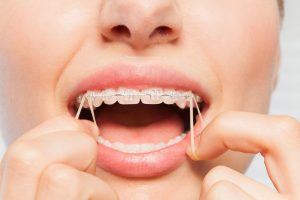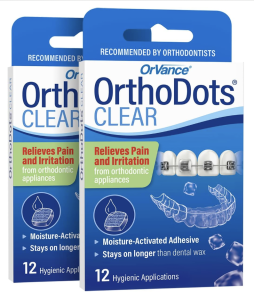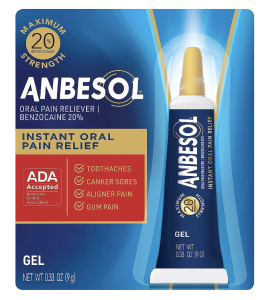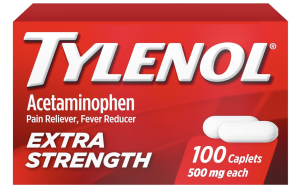Why do braces hurt? If you ask your grandmother she might tell you that beauty is pain, but there's actually a simple medical explanation. Braces hurt because your teeth are being pushed and pulled, creating pressure that causes increased sensitivity. They can also cause pain because of cuts and scratches from the metal brackets.
The good news is that orthodontics and braces pain is manageable, and anyone who has had severely crooked teeth will tell you that in retrospect, adult braces are usually worth it once you have a beautiful, straight smile.
In this article we'll go over:
- Why braces hurt
- When braces hurt
- What you can do to stop the pain
In This Article
The phases of braces pain
If you've ever had braces before, just reading this article is enough to trigger the memories of scratched inner cheeks, endless sores, and a constant aching radiating from your jaws. And if you just got or are about to get braces for the first time…well, it's a good idea to prepare yourself for what's coming so you know what's normal and how to ease braces teeth pain or discomfort.
So first, let's take a look at some of the most common points throughout treatment when people tend to feel some pain.
Braces pain when you first get them
Many people are afraid of getting their braces put on because they fear the process will be painful. Fortunately, actually getting your braces on doesn't hurt. It's what comes after that typically causes some pain.
During your appointment, your orthodontist will apply glue to each of your teeth, and then glue brackets onto each one. The brackets are then connected with wires and secured with elastic bands. These bands are what give braces their colors.


It's a few hours after this, when you've returned home and are beginning to think that it wasn't that bad after all, that you'll begin to notice some soreness in your teeth and gums. It's not unbearable, but it is constant. This soreness is caused by the wires and bands putting pressure on your teeth and slowly forcing them into their new position.
You may also experience sores on the inside of your cheeks or on your tongue from sensitivity to the metal brackets. The discomfort should ease significantly after a week, but it may take up to a month before you feel completely used to wearing your braces.
Pain during brace tightening
As part of braces treatment, you'll visit with your orthodontist every two to four weeks to get them tightened and to have any adjustments made. Your orthodontist will tighten your wires and springs, to ensure that your teeth keep moving in the right direction.
Getting braces tightened isn't usually painful in the moment. However, after these adjustments, it's normal to feel some braces tightening pain and soreness, similar to what you felt when you got your braces on. It won't be as intense and should pass within a few days.
Even though teeth can be moved and straightened at any age, adult orthodontic treatment is sometimes a more involved process than it is for younger patients. In certain cases, a combination of orthodontic/orthognathic (dentofacial) surgery treatment may be recommended for adult patients with a severely misaligned jaw structure. If this is the case, treatment may require coordination with a general dentist.
Just like with younger patients, good oral hygiene habits are essential to the success of treatment for adult orthodontic patients. In fact, due to the prevalence of periodontal disease in adults, it is even more important that adult patients practice excellent oral hygiene.
You can also expect slight discomfort in your mouth and teeth after your adjustments, or when you are putting in a new aligner for your Invisalign treatment – this is temporary and completely normal.
Dr. Clarke Stevens
Getting them off
The process of getting your braces off won't hurt, although once you're at home, you might notice some tenderness or even soreness. Just as at the beginning your teeth needed to adjust to constant pressure, now they have to adjust to a lack of pressure. Additionally, you may experience a bit of soreness because your orthodontist might have to use some force to get all of the brackets and glue off. This tenderness will go away soon, but in the meantime, you may want to stay away from hard foods that can cause you more braces teeth pain.
Other reasons for braces pain
Let's take a look at some of the other reasons your braces might cause you pain during treatment.
Rubber bands braces pain


Rubber bands are often part of braces treatment. They hook on to specific brackets and help to fix bite alignment issues. These can cause the same type of soreness as your braces do after a tightening, especially if you leave them off for too long.
Pain from power chains
Power chains are elastic ligatures that connect to each bracket and are used to close gaps between teeth and to do it quickly. Power chains are efficient because of the extra pressure they add to your teeth, but this also means that they can add some extra pain to the whole process. Some people experience intense soreness after getting their power chains on, while others get away with just a bit of a tight feeling. Further down, we'll talk about some ways to make braces stop hurting from power chains.
Scratches from brackets
The inside of your cheeks are soft and sensitive, and metal braces have all sorts of pointy edges. Hooks and bracket edges can catch on cheeks or your tongue, causing some pretty nasty cuts and wreaking havoc on those mouths that are prone to canker sores.
The good news is that your cheeks and tongue will actually develop calluses to protect themselves from your brackets so that soon these sores will hardly be a problem. Before you develop calluses though, you'll want to keep plenty of dental wax on hand, which we'll talk more about below.
Homemade braces
Unfortunately, there is a trend, mostly among kids and preteens, to make your own braces at home. These homemade braces are extremely dangerous and can definitely cause pain. See your dentist immediately if this is your situation.
Do aligners hurt less than braces?


In general, aligners hurt less than traditional braces because of the materials and movement involved. It may seem like an obvious observation, but it's also been shown in studies like this one. The study concluded that patients using Invisalign experienced lower levels of braces teeth pain than those with fixed braces during the first few days of treatment.
But why does Invisalign hurt less than braces? For a couple of reasons:
- Less movement: Aligners are generally used in cases where only mild or moderate correction is needed, meaning less shifting and moving of your teeth and ultimately, less pain.
- Smooth edges: Aligners don't have pointy metal brackets that will poke and catch on your cheeks and tongue. The top edges may cause some irritation at first, but nothing compared to brackets.
That doesn't mean that aligners don't hurt—they are moving your teeth after all, which is an inherently painful process. But if you are eligible for aligners and you want to avoid as much discomfort as possible, you may want to consider aligners instead of traditional braces.
For mild to moderate correction, we recommend some brands over others, including Candid, Byte (read Byte reviews), NewSmile, and ALIGNERCO, which you can compare below:
- Hybrid in-office and remote treatment
- In-person visits with your orthodontist for safe, effective treatment
- Treats even complex cases of misalignment
- Various pricing options
Discover the flexibility and effectiveness of Impress Invisible Braces, the hybrid orthodontic solution that blends in-person care with the convenience of remote appointments. Suitable for both kids and adults, Impress offers a range of treatment options designed to cater to various needs, from mild to severe cases of misalignment. With the initial consultation happening in person, you're assured of a tailored treatment plan that can address even the most complex orthodontic issues.
Impress Treatment Plans:
- Impress Super Light ($6,999): Perfect for mild cases, this plan promises results in up to 3 months, making it the quickest route to a better smile.
- Impress ($4,599): Designed for moderate cases, this option aims to perfect your smile within 4-10 months.
- Impress Plus ($5,599): Tailored for moderate cases requiring a bit more time, this plan spans 11-14 months.
- Impress Advanced ($6,999): The go-to choice for complex cases, offering comprehensive treatment over 11-24 months.
- Teens ($4,599): Specifically designed for teenagers, this plan addresses mild cases within 4-10 months, ensuring a confident smile during those crucial years.
- Impress Kids ($4,599): Offering orthodontic treatment for children, this plan covers a period between 8-18 months, setting the foundation for a lifetime of healthy smiles.
With flexible payment plans available, starting your journey to a perfect smile has never been easier or more accessible. Whether you're looking for a quick fix or need extensive treatment, Impress Invisible Braces provide a tailored solution that meets your needs and budget. Click below to get started!
- 3-4 month average treatment time
- Assessed and planned by orthodontists
- Includes whitening and first retainers
- $1,999 or $70/month
Byte's HyperByte technology uses High Frequency Vibration to help your teeth move faster and with minimal discomfort. Their average treatment time is just 3-4 months, compared to 6 months for most others.
Treatment includes your first set of retainers. You'll also get their BrightByte 3-in-1 foam to whiten your teeth, clean your aligners and freshen your breath. And their Byte-for-life guarantee means you'll get free adjustments if your teeth start to move again.
Begin by ordering an impression kit so their orthodontists can assess whether you're a good match.
- Complete treatment 100% remotely
- Amazing customer service
- Nighttime-only option
- $1,495 or $55/month
NewSmile aligners are made from the clearest Essix plastic and come with a daytime or nighttime-only option to suit you. For just $1,495 you'll receive everything you need to straighten and whiten your teeth – and maintain your new smile:
- Home impression kit
- Full aligner treatment
- Free whitening
- First set of retainers
- A full refund if you're not a good fit
NewSmile goes above and beyond to provide a great experience to all their customers, beginning with a live video call to help you with your teeth impressions. Mail these back, and they'll send a 3D Treatment Preview for you to approve before going ahead.
- Smileie Pro offers hybrid treatment!
- Single-arch treatment option
- Nighttime aligners available
- Free refinements & 2 sets of retainers
- $699 (single-arch) or $999 (dual-arch)
Smileie's aligner treatment is not only affordable, but flexible too. You have the option of Smileie Pro, which is hybrid treatment that involves in-office visits with a dentist.
That means more accurate, safer and effective treatment or a wider variety of cases.
But you can also opt for single-arch treatment for just your top or bottom teeth, as well as nighttime-only treatment. And whichever package you choose, monthly payments are available.
On top of this, Smileie offers a 100% satisfaction guarantee which includes free refinements if needed. Their aligners are made in the US and treatment takes 4-6 months on average.
Get Smileie Pro for just $1499, or —
Get the best discount on the standard plan, with 100% remote treatment, when you purchase your aligner package up-front, including:
- Home impression kit
- Teeth whitening kit
- Two sets of retainers
- A full refund if you're not a good candidate
Packages start at $699 for single-arch treatment. Click below to check for current discounts!
- Complete treatment 100% remotely
- 4-6 month average treatment time
- Nighttime-only option
- $949 or $77/month
If you're looking for the best value aligner package, here it is! For just $895 you'll get:
- Impression kit
- Full aligner treatment course
- Free teeth whitening kit
- Your first set of retainers
In short, everything needed to straighten your teeth remotely and keep them looking great, with a full money-back guarantee if you're not a suitable candidate.
This low price doesn't mean you're compromising on quality of care, though. ALIGNERCO just choose not to put so much into marketing, and they pass on the savings to their customers. They are also known for their responsive and helpful customer care, which is important when you're doing things from home.
Plus, if you're in New York, you can visit their SmileStudio for a free consultation and help taking your impressions.
Nighttime-only aligners are also available for anyone who doesn't want to wear aligners during the day.
- Complete treatment 100% remotely
- Single or dual-arch treatment
- Nighttime-only option
- Just $849 (single-arch) or $1149 (dual-arch)
Caspersmile aligners offer the most affordable way to correct minor dental misalignment invisibly and without any discomfort. Their single-arch treatment costs just $849. This price includes everything you need, including:
- Impression kit
- Personalized treatment plan
- Clear aligners
- 1st set of retainers
- Teeth whitening kit
- Caspersmile guarantee
Caspersmile offers great customer service too — with unlimited video consultations with your Smile Specialist, the liaison to the Caspersmile dentist in charge of your case.
Begin your teeth straightening journey by taking a free Smile Assessment today.
Brace pain relief
If you just got braces, you're probably wondering how to get rid of braces pain. Thankfully, there are plenty of things you can do to. Check out the following orthodontist recommendations:
1. Soft foods for sore teeth from braces
Go easy on your teeth when you first get your braces and after you get them tightened. That means thinking twice before you bite into that apple—swap it out for some applesauce. Other soft foods for braces include:
- Smoothies
- Yogurt
- Cold soup
You can also eat warm foods like mashed potatoes or oatmeal, but you may find that cold foods help to relieve inflammation and soothe your mouth more than hot foods.
2. Saltwater rinses
Yes, eating cold foods will help ease the pain, but so will saltwater rinses with warm water. Warm saltwater will work as an antiseptic to gently wash away bacteria and bring down swelling. This is recommended especially when dealing with soreness from power chains and rubber bands.
3. Orthodontic wax
If you experience sores from your brackets catching on your cheeks, you will quickly develop a profound love of orthodontic wax. Orthodontic wax is oh-so-smooth and is molded over any bracket that causes you irritation, creating a soft protective barrier between your cheeks and your brackets.


If you find yourself with orthodontic wax covering nearly all of your brackets during the first week, or if you have a canker sore outbreak, you're definitely not alone. Just make sure to take the wax off when you eat and when you brush your teeth.
Your orthodontist will most likely provide you with a generous supply of wax, but you can also purchase it from drugstores or on Amazon.
4. Anesthetics
Fast relief from your braces pain can come from oral anesthetics like Orajel or Anbesol. These can be applied directly to your affected areas and help to temporarily numb them to relieve pain, whether on your gums or cheeks.
5. Over-the-counter painkillers
Ibuprofen, Advil, or Tylenol can be taken after you get your braces on (or after you get them adjusted) to help relieve pain caused by your shifting teeth.
You can take the appropriate dosage of an over-the-counter painkiller before an orthodontic appointment as well to get a jumpstart on relieving the pain. Just make sure not to take too high of a dosage and keep in mind that these painkillers aren't meant for continuous usage.
6. Chill out
Literally! Cold will help reduce inflammation, whether it's coming from swollen gums or cuts on your tongue and cheeks. Simply sip ice water throughout the day or use an icepack on the outside of your mouth.
7. Gum massage
It may sound silly, but if you're experiencing pain from shifting teeth, you know you're willing to try just about anything to get some braces pain relief. Just as you can massage your shoulders to relieve sore muscles, you can use your fingers to gently rub your gums in a circular motion to relieve some of the pain.
In the following table, you can see a summary of the reasons for braces pain and common braces pain remedies:
Source of pain | Remedy |
Teeth moving |
|
Cuts from brackets |
|
Both |
|
And in the video below, Dr. Greg Asatrian gives his best tips for how to relieve pain from braces. You'll see that the methods for how to deal with braces pain are pretty universal.
Conclusion
If you need braces, it won't be the most comfortable experience, but it's manageable. The process of moving teeth is bound to cause some pain, or at least some discomfort, although some people experience more pain than others. This pain can be internal, caused by the actual shifting of your teeth, or external, caused by cuts and sores where the soft tissues of your mouth come into contact with the metal brackets.
Braces pain is no reason not to straighten your teeth, as there are plenty of ways to alleviate your pain, including cold compresses, orthodontic wax, and over-the-counter painkillers.
If you need only mild to moderate treatment, you may be able to opt for invisible braces or clear aligners, which typically straighten teeth with considerably less pain than traditional braces.
FAQs
Does it hurt to get braces on?
The actual process of getting your braces glued to your teeth doesn't hurt. It will feel weird during those first moments, but a few hours later you will begin to notice some pain or discomfort. That's good! It means that your teeth are beginning the process of moving into alignment. You can ease the pain by taking over-the-counter painkillers, drinking ice water, or using a cold compress on the outside of your mouth.
How long do braces hurt when you first get them?
Your braces will hurt for the first couple of days after you get them and you may experience some cuts from the brackets. By the end of the first week, your pain should largely subside. When you get your braces tightened, you might feel some pain again, but it will only last for a couple of days.
How long do braces hurt after tightening?
Braces pain after tightening should only last for a couple of days, and it shouldn't last as long as the initial pain from first getting your braces on did. Rubber bands or chains can also cause pain.
Does it hurt to get braces off?
Getting your brackets taken off doesn't hurt. However, your orthodontist may have to use some force to remove braces by pushing on the brackets and the glue, which can leave your mouth feeling a bit tender afterwards. You also may notice some tenderness simply from the absence of pressure your teeth had gotten so used to.
NIH: Pain level between clear aligners and fixed appliances: A systematic review. Consulted 8th November 2020.










